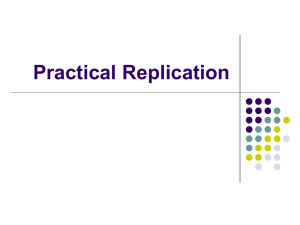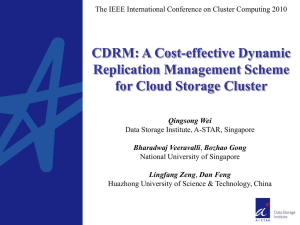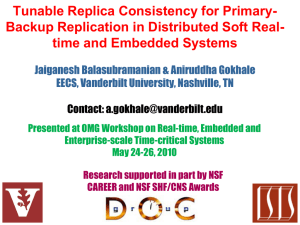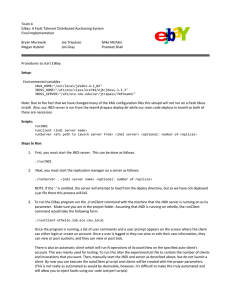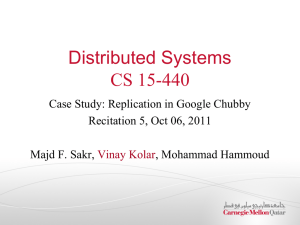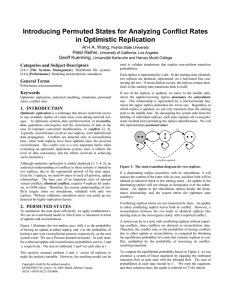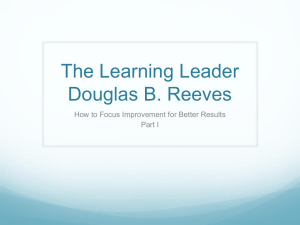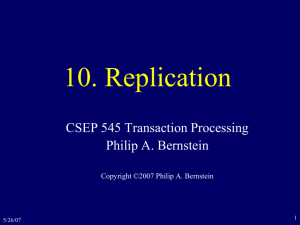Slides
advertisement
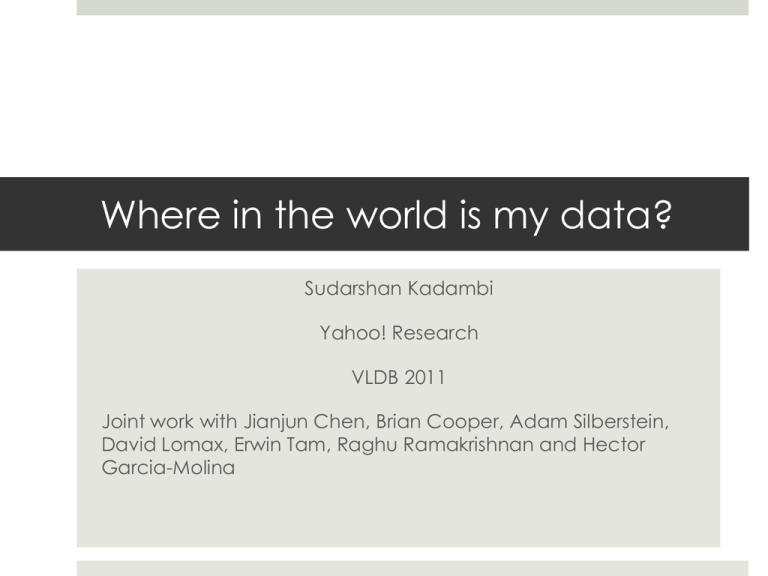
Where in the world is my data?
Sudarshan Kadambi
Yahoo! Research
VLDB 2011
Joint work with Jianjun Chen, Brian Cooper, Adam Silberstein,
David Lomax, Erwin Tam, Raghu Ramakrishnan and Hector
Garcia-Molina
Problem Description
Consider a distributed database, with replicas kept in-sync via.
an asynchronous replication mechanism.
Consider a social networking application that uses this
distributed database.
Consider a user who is based in Europe.
If user’s record is never accessed in Asia, we shouldn't need to
pay the network/disk bandwidth to update the record in the
Asian replica.
Criteria used to replicate a given
record
Dynamic Factors
How often is the record read vs. updated?
Latency of forwarded reads.
Static Factors
Legal Constraints
Critical data items such as billing records might have
additional replication requirements.
In this presentation, we’ll look at selective replication at a record
level that respects policy constraints and minimize replication costs
and is tuned to support latency guarantees.
Architecture
PNUTS.
Asynchronous Replication.
Timeline Consistency.
Replicate everywhere.
With selective replication, some replicas have a full copy of
record, others only have stubs.
Each stub has the primary key and additional metadata such
as list of replicas that have a full copy of the record.
Read for a record at a replica that contains a stub will result in a
forwarded read.
Optimization Problem
Given the following constraints:
Policy constraints that define the allowable and mandatory
locations for full replicas of each record, and the minimum
number of full replicas for each record, and
A latency SLA which specifies that a specified fraction of read
requests must be served by a local, full replica
Choose a replication strategy to minimize the sum of replication
bandwidth and forwarding bandwidth for a given work- load.
Note: Total Bandwidth = Update Bandwidth + Forwarding
Bandwidth
Policy Constraints
Based on legal dictates, availability needs and other application
requirements.
[CONSTRAINT I]
IF
TABLE_NAME = "Users”
THEN
SET 'MIN_COPIES' = 2
SET 'INCL_LIST' = ’USWest'
CONSTRAINT_PRI = 0
Policy Constraints (contd.)
[CONSTRAINT II]
IF
TABLE_NAME = "Users" AND
FIELD_STR('home_location') = 'france'
THEN
SET 'MIN_COPIES' = 3 AND
SET 'EXCL_LIST' = ’Asia'
CONSTRAINT_PRI = 1
Constraint Enforcement
Master makes an initial placement decision when the record is
inserted.
R and stub (R) are published to the messaging layer in a single
transaction.
If record contents change, full copies can migrate
(promotions/demotions).
Constraints are validated when they're supplied.
Our system don't allow constraints to be changed after data is
inserted.
Dynamic Placement
Retention Interval
Too short: locations will be quick to surrender full
replicas.
Too long: single read can cause a full replica to
be retained for a long time.
Latency constraints
Dynamic placement places full copies where
reads exceeds writes and stubs elsewhere.
Might be necessary to make extra full copies so
that latency SLA is met.
One way to accomplish is by increasing the
number of copies.
Another is to increase the retention interval I.
Experimental Setup
Social networking application.
Users have a home location from where their
reads and writes originate.
Varied the remote probability, the read/write
ratio, the size of reads/writes and user mobility.
For constraint schemes, we use min copies of 2.
Each record must have a full copy at the user's
home location.
Configuration
Clusters in data centers in US, India, Singapore.
100,000 1 /KB records.
5M read/write operations for each data point.
For dynamic schemes, generated a trace of 6M
operations and used the first 1M for warmup.
Varying read/write proportion
Insight: Dynamic scheme performs well with increasing number of writes,
as it can keep as few as one copy. Due to the adaptation overhead,
Dynamic with Constraints performs worse than Static Constraints.
Varying read/write proportion
Insight: Latency of the dynamic scheme increases as write proportion
increases, as the likelihood increases that an update reaches an expired
full replica and causes the demotion of that replica to a stub. Hence
there is fewer full replicas, increasing overall latency.
Impact of Locality
Insight: As remote probability increases, even though the proportion of
writes remains the same at 10%, the effect of those writes get amplified
as a higher proportion of records at a replica are obtained adaptively.
Impact of Locality
Insight: Static Constraints pays the penalty of having to repeatedly do
forwarded reads for friend’s records, without being able to store those
records locally.
Real Data Trace
10 days of logs,170,000 unique users, 32 million
operations.
The trace is read-heavy; About 40% operations are
remote.
Dynamic with Constraints get similar average read
latencies (about 4ms) as Full.
Total bandwidth for Full is 8 Mb and 6.8 Mb for Dynamic
with Constraints.
Comparison with other techniques
Caching.
Replication.
Our Technique: Caching + Replication
Minimum bookkeeping.
Local + Global decision making.
Also applicable to other web databases such
as BigTable and Cassandra.
Related Work
Adaptive Dynamic Replication (Wolfson et al.)
Data Replication in Mariposa (economic model)
Minimal cost replication for availability (Yu and Vahdat)
Cache placement based on analyzing distributed query
plan (Kossmann et al.)
Replication strategies in peer to peer networks (Cohen
and Shenker)
Conclusion
Proposed mechanism for selectively replicating data at a
record granularity while respecting policy constraints.
Currently being rolled out to production at Yahoo.
Examined a dynamic placement scheme with small
bookkeeping overhead.
Experimental results show significant improvement in bandwidth
usage.
Tunable in order to meet latency constraints.
Thank You
Eventual Consistency
Application can apply concurrent updates to different replicas
of the same record in parallel.
PNUTS publishes changes asynchronously to other replicas and
resolves conflicts using the local timestamp of each write.
With selective replication: updates are not published to stubs,
this may cause a replica to not eventually receive all changes
to a record.
To address this, require a full replica to republish its write after
detecting overlapping promotions for other replicas of the
same record.




